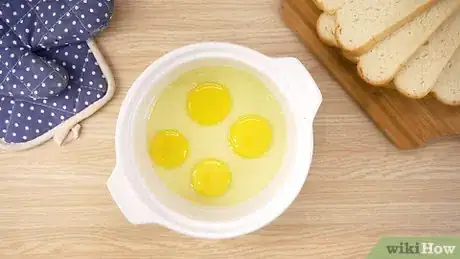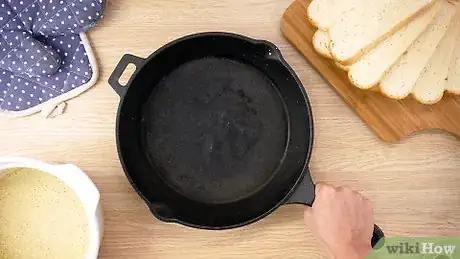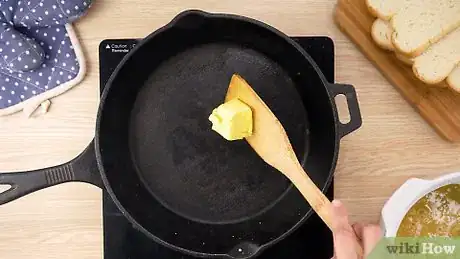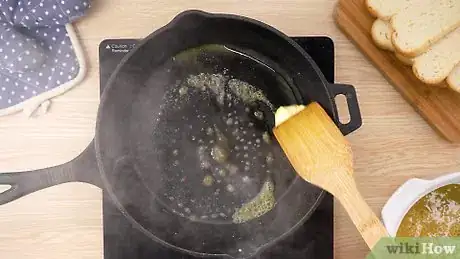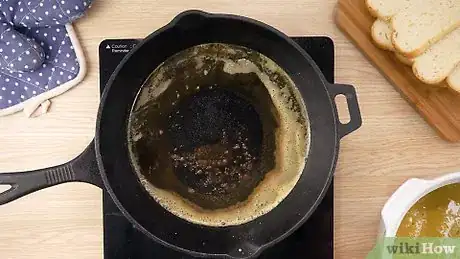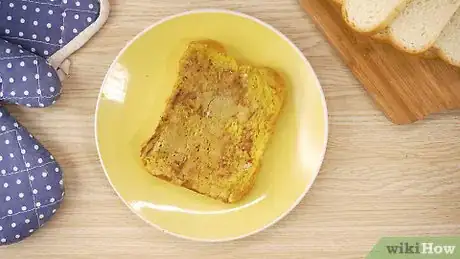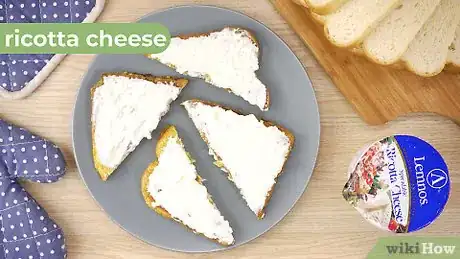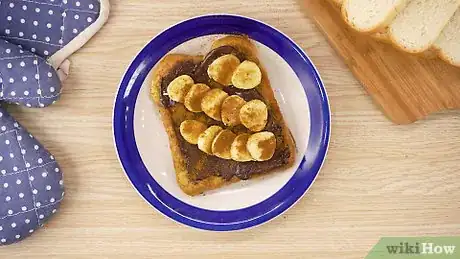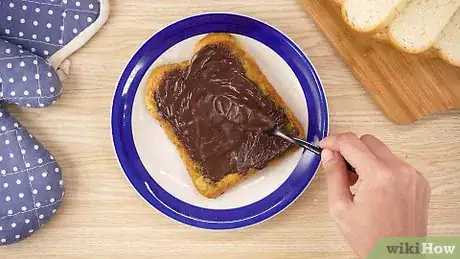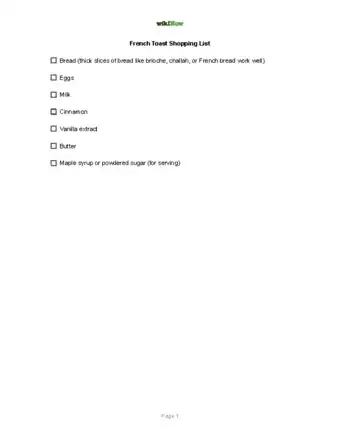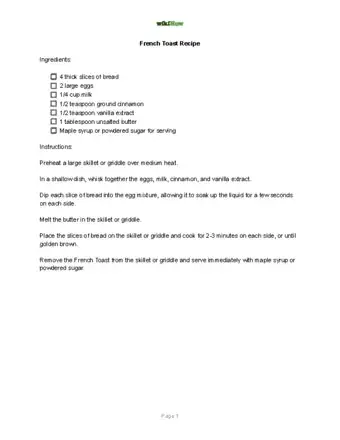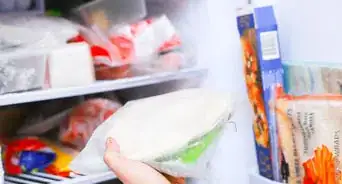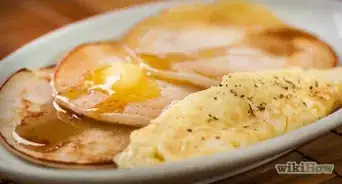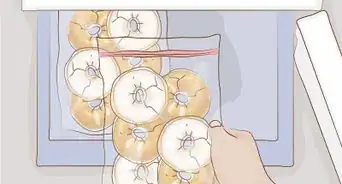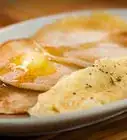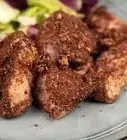This article was co-authored by Jennifer Lease, RD, CDN. Jennifer Lease is a Registered Dietitian and Trained Chef based in Denver, Colorado. With six years of experience in the food and nutrition fields, she specializes in a plant-forward approach to applying nutrition information to cooking. Jennifer holds a BS in Dietetics and a Dietetic Internship Certificate from The University of Delaware. She also received her professional chef training from The Natural Gourmet Institute for Health and Culinary Arts.
wikiHow marks an article as reader-approved once it receives enough positive feedback. This article has 36 testimonials from our readers, earning it our reader-approved status.
This article has been viewed 7,450,371 times.
French toast is a delicious, classic breakfast dish made with sliced bread, eggs, milk, and a few sweet ingredients. The goal is to make your toast rich and fluffy by making your batter just right, and cooking your toast at the right temperature until it is golden brown and the egg has been fully cooked. Making the dish was originally a resourceful way to use stale bread, so if you have any laying around, this is a good opportunity to put it to good use. French toast quick and easy with the right know-how, and soon you will be able to make it perfectly for yourself or a group.
Ingredients
- 8 bread slices
- 4 large eggs
- 2⁄3 tablespoon (9.9 mL) of milk
- 1 teaspoon (4.9 mL) of vanilla extract
- 1 teaspoon (2.6 grams) of cinnamon
- ¼ cup (32 grams) of flour (optional)
- ¼ cup (32 grams) of sugar (optional)
- ¼ teaspoon (1.4 grams) of salt (optional)
- Butter or non-stick spray
Makes 4-8 servings
Steps
Making the Batter
-
1Crack 4 large eggs into a large bowl. Eggs will blend much better if you allow them to sit at room temperature for 10-15 minutes prior to cracking.[1]
-
2Add milk, vanilla extract, and cinnamon to the bowl. Measure out 2⁄3 tablespoon (9.9 mL) of milk and mix it into the bowl of eggs. Then, mix in 1 teaspoon (4.9 mL) of vanilla extract, followed by 1 teaspoon (2.6 grams) of cinnamon. It's important to add the ingredients separately, since delicate eggs whites need to incorporate ingredients one at a time.[2]
- Use whole milk for a higher fat content, if desired. The more fat, the thicker and richer the batter will be.[3]
- If you want a sweeter taste, you can add ¼ cup (32 grams) of sugar or a dash of honey to the mixture as well.
- Adding ¼ teaspoon (1.4 grams) of salt can help smooth out the mixture.
Advertisement -
3Beat the mixture together with a fork or whisk. Use the fork or whisk in a rapid circular motion, avoiding any spillage or spraying. The yolk should break apart quickly, at which point you should focus on mixing the ingredients together.[4]
- When the batter is finished, it will look smooth and have a consistent tan color all throughout.
- Be sure to whisk the egg thoroughly to avoid egg chunks in the batter.
-
4Add flour to thicken the batter and make fluffier toast, if desired. Whisk ¼ cup (32 grams) of flour in just like the rest of the batter ingredients. You don’t have to get every clump of flour to break up, but aim for a smooth, uniform mixture.[5]
Flour is not necessary, but many restaurants use flour to improve the texture. It gives the toast a less soggy, more fluffy texture.
Cooking the Toast
-
1Place a cast-iron pan on the burner, if you are using a stove. Choose a cast iron skillet that's large enough to hold 2 slices of bread comfortably, if possible. For large batches of French toast, a large griddle may be a more efficient choice than a skillet.[6]
-
2Add 1 tablespoon (15 mL) butter or spray the pan with nonstick spray. Drop around 1 tablespoon (15 mL) of butter on the middle of the pan so that it can spread out evenly as it melts. If you use nonstick cooking spray, coat the bottom of the pan thoroughly to prevent sticking.[7]
- If you're using a griddle, nonstick cooking spray is usually a better option.
- Butter will enhance the flavor more than nonstick cooking spray, but the spray can help reduce the fat content of an already heavy dish.
-
3Set the stove to medium high heat or heat your griddle to 350 °F (177 °C). Let the skillet or griddle heat up completely. If you're using butter, make sure it melts completely before proceeding.[8]
-
4Turn the heat down to medium-low once the butter melts. If you are using butter, the pan is hot enough when the butter is melted. If you're using an electric griddle, keep an eye on the temperature setting and proceed once it's fully preheated.
- Frying at full temperature will burn the bread and cause the inside to stay raw.
- If medium-low heat seems too low, you can raise it a bit, so long as you don’t go over medium heat.
-
5Coat 2 slices of bread at a time with the egg mixture. You can dip the bread in the mixture with your fingers or use tongs if you would rather not touch the batter. For a light coating, quickly dredge the bread a few times, or let the bread soak in the mixture for between 30 seconds to 5 minutes, flipping the slices halfway through.[9]
- Soaking the bread is better for stale, crusty, or thick bread, and may cause thin sandwich slices to get too soggy. For sandwich slices, 30-60 seconds should be enough.
- Don't soak the bread too long or it will get extremely soggy and may break apart while you cook.
- Use a cake or brownie tin instead of a large bowl if you are making large batches.
-
6Place each coated slice of bread into the hot pan. You can use your fingers or tongs to transfer both bread slices to the pan or griddle. Lower the bread gently onto the hot surface to prevent the butter from splashing on you.[10]
-
7Cook the toast for 1 to 4 minutes on each side, or until golden. Let the toast brown on each side before using a spatula to flip the toast over. Be sure to check for underdone runny egg inside of the toast before calling it done.[11]
- You can sprinkle sugar over the bread while it's in the pan before flipping it. This will create a crunchy layer of caramelized sugar. If you added sugar to the batter already, this may cause the toast to become too sweet.
Serving French Toast
-
1Place the French toast on a serving plate straight from the pan. Using tongs, a flat spatula, or a fork, lift the toast off the skillet and onto a plate. Serving the toast hot will enhance the egg flavor, without feeling cold or getting soggy again.
-
2Try ricotta cheese for a more savory option. Ricotta is a delicious spreadable cheese that walks the line between savory and sweet, making it the perfect choice for French toast. It will add a new twist on the toast that will pair especially well with fruits and savory side dishes like bacon or sausage.[12]
-
3Add a fruity topping to add some flavor. Alongside other toppings, sliced fresh fruit, berries, jams, and hot applesauce all make great additions to French toast. This topping can be used at any meal. Combine it with cheese for a savory flavor, or with syrup and sugar for a dessert dish.[13]
- Halved strawberries, apple slices, raspberries, blackberries, and blueberries all make great flavor combinations with French toast.
-
4Sprinkle on cinnamon or powdered sugar. These each go well with any sweet topping you can think of, and they are staple toppings for French toast. Sprinkle them on in moderation if you are also serving the toast with syrup or another sweet topping, unless you are going for an all-out dessert.[14]
- Cocoa powder will add a chocolate flavor that could pair well with fruit.
-
5Spread some chocolate on the toast. Using a chocolate spread will turn French toast into a delicious dessert. Spread some on each slice with a knife like butter to add this sweet, flavorful topping to your French toast.
- Try a chocolate and hazelnut spread to change up the flavor a bit.
-
6Drizzle syrup on the toast for a classic breakfast flavor. Whether maple or plain sugar syrup is more your style, it will make a sweet and delicious addition to your French toast. If you are serving others your French toast, serve the syrup on the side so that they can decide how much or how little they would like.[15]
- For another sweet drizzle, try honey. It’s sweet and flavorful, yet unique enough to add a twist on French toast.
Shopping List and Recipe
Community Q&A
-
QuestionIs it okay to cook it on low?
 Community AnswerYes, it will take a little longer, but you are less likely to burn your toast.
Community AnswerYes, it will take a little longer, but you are less likely to burn your toast. -
QuestionDo you have to use eggs?
 Community AnswerYes. Eggs are the entire point of French toast.
Community AnswerYes. Eggs are the entire point of French toast. -
QuestionDo I have to use vanilla in the recipe?
 Community AnswerNo, you do not. Vanilla simply adds a subtle flavor that many people find tasty. You can omit the vanilla entirely.
Community AnswerNo, you do not. Vanilla simply adds a subtle flavor that many people find tasty. You can omit the vanilla entirely.
wikiHow Video: How to Make French Toast
Warnings
- Always cook French toast thoroughly. Raw eggs can cause you to feel sick if eaten.[17]⧼thumbs_response⧽
Things You'll Need
- Large bowl
- Pan or skillet
- Stove or griddle
- Fork or whisk
- Spatula
- Serving plate
References
- ↑ https://tastesbetterfromscratch.com/classic-french-toast/
- ↑ https://tastesbetterfromscratch.com/classic-french-toast/
- ↑ https://tastesbetterfromscratch.com/classic-french-toast/
- ↑ https://www.rachelcooks.com/2019/02/04/french-toast-recipe/
- ↑ https://tastesbetterfromscratch.com/classic-french-toast/
- ↑ https://www.bbcgoodfood.com/howto/guide/how-make-french-toast
- ↑ https://www.bbcgoodfood.com/howto/guide/how-make-french-toast
- ↑ https://tastesbetterfromscratch.com/classic-french-toast/
- ↑ https://www.bbcgoodfood.com/howto/guide/how-make-french-toast
- ↑ https://tastesbetterfromscratch.com/classic-french-toast/
- ↑ https://tastesbetterfromscratch.com/classic-french-toast/
- ↑ https://ourbalancedbowl.com/ricotta-french-toast/
- ↑ https://www.rachelcooks.com/2019/02/04/french-toast-recipe/
- ↑ https://www.rachelcooks.com/2019/02/04/french-toast-recipe/
- ↑ https://www.bbcgoodfood.com/howto/guide/how-make-french-toast
- ↑ https://countryrecipebook.com/easy-country-french-toast/
- ↑ https://www.cdc.gov/foodsafety/communication/salmonella-and-eggs.html
About This Article
To make french toast, first gather your materials. To make about a dozen slices, combine 6 eggs, 3/4 cup (175ml) of milk, 1 tsp vanilla extract, and a bit of cinnamon in a bowl. Beat the ingredients with a fork or whisk. Once the ingredients are thoroughly mixed, dip a slice of bread into the bowl and let it soak for up to 20 minutes. During this time, heat a few tablespoons of butter in a pan over medium-high heat. Once the butter starts to sizzle, turn the temperature down to medium-low. Cook each side of the bread for 45 seconds, then serve!
